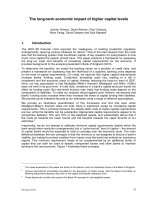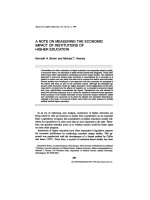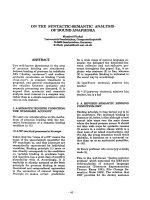Economic Impact Analysis pot
Bạn đang xem bản rút gọn của tài liệu. Xem và tải ngay bản đầy đủ của tài liệu tại đây (183.33 KB, 19 trang )
© Harry Campbell & Richard Brown
School of Economics
The University of Queensland
BENEFIT-COST ANALYSIS
BENEFIT-COST ANALYSIS
Financial and Economic
Financial and Economic
Appraisal using Spreadsheets
Appraisal using Spreadsheets
Ch 13: Economic Impact Analysis
What is the difference between Net Present Value
and Economic Impact?
Keynes gives the example of land, labour and capital used in two
alternative ways:
1. To dig a hole in the ground;
2. To build a hospital.
The two projects have the same economic impact, in terms of
generating income for factors of production and inducing additional
expenditures, but the hospital has a higher net present value than the
hole in the ground.
Figure 13.1 The Circular Flow of Income
$ GOODS FACTORS $
GOVERNMENT
HOUSEHOLDS
FIRMS
The Circular Flow of National Income
The National Income Multiplier
Consider three models which can be used to derive the national
income multiplier:
1. A closed economy, no taxes;
2. A closed economy, with exogenous taxes;
3. An open economy, with endogenous taxes.
Symbols:
Y = national income; C = consumption expenditure;
S = Savings; I = investment expenditure;
T = tax revenues; G = government expenditure;
X = value of exports; M = value of imports
Model 1: Closed economy, no taxes
Y = C + I + G
C = A* + bY,
where A* is autonomous consumption expenditure, and
investment and government expenditure are exogenous.
Substitute to get:
Y = A* + bY + I* + G*
where “ * ” indicates a variable which is exogenous to the model
(i.e. is assumed to be constant).
Solve to get:
Y = (1/(1-b))(A* + I* +G*),
where (1/(1-b) is the national income multiplier.
Now dY = (1/(1-b) dG*
Model 2: Closed economy, with exogenous taxes
Y = C + I + G
C = A + b(Y - T)
Substitute:
Y = A* + b(Y - T*) + I* + G*
Solve:
Y = (1/(1-b)(A* + I* + G* - bT*)
Now:
dY = (1/(1-b)(dG* - bdT*)
Note that if extra government expenditure is financed
by increasing tax revenues, dG* = dT*,
dY = dG*
i.e. the balanced budget multiplier is 1.
Model 3: Open economy, with endogenous taxes
Y = C + I + G + X - M
Note that X is added because income is generated in production
of exports, but the component of C+I+G that represents imports
(M) is subtracted because no domestic income is generated by
imports.
C = A + b(Y - T)
T = tY
M = mY
Substitute:
Y = A* + b(Y - tY) + I* +G* + X* - mY
Solve:
Y = [1/(1-b(1-t)+m)](A* + I* + G* + X*)
Using plausible values: t=0.3; m=0.25; b=0.9, the multiplier
takes the value 1.45.
The Employment Multiplier
Suppose that average per worker income is $y. The number of
‘jobs’ in the economy is, therefore: L = kY, where k = 1/y.
The extra number of jobs resulting from an increase in
government expenditure is, therefore: dL = kdY , which, from
Model 3, can be written as: dL = k[1/(1-b(1-t)+m)]dG* ,
where k[1/(1-b(1-t)+m)] is the employment multiplier.
Some points to note:
1. The size of the multiplier is inversely related to the size of the
‘leakages’: (1-b), t, m.
The smaller the region (extent of the referent group) the larger the
leakage caused by imports, and the smaller the multiplier.
2. National income, Y, is expressed in nominal terms. We can
think of Y being the product of the average price of goods and
services, P, times the quantity produced, Q.
Y = PQ
An increase in Y could be caused by changes in P and/or Q:
dY = dP.Q + P.dQ
but only changes in Q generate changes in real income.
In other words, some of the multiplier effect could represent
inflation.
3. Any project involving the use of scarce factors of production will
generate income and, hence, expenditures and a multiplier effect. In
comparing the economic impact of projects, it is the relative
multiplier effects that count, and these may not differ significantly.
4. Multiplier effects may be particularly associated with the
construction phase of a project, and, in that case, will be of limited
duration.
5. Multiplier effects can be considered a benefit of the project only
in so far as they are ‘real’ (i.e. represent the value of extra output
net of any additional opportunity costs), and would not have
occurred in the absence of the project (i.e. would not have been
generated by an alternative project).
Table 13.1: Inter-Industry Structure of a Small Closed Economy
_________________________________________________________________
Sales Final Demand Gross Output
1 2 3
_________________________________________________________________
Purchases 1 100 400 300 200 1000
2 0 400 900 700 2000
3 0 0 600 2400 3000
_________________________________________________________________
Value Added 900 1200 1200 3300
_________________________________________________________________
Gross Output 1000 2000 3000
_________________________________________________________________
Inter-Industry Analysis
The fixed coefficients of an input-output model
Where y
i
is final demand for the output of industry I.
If the coefficient a
ij
is used to represent
the sales of industry i to industry j per
dollarÕs worth of ou tput of industry j, t hen
total sales of industry i to industry j can be
represented by:
x
ij
= a
ij
x
j
,
And t otal value of ou tput of industry i can
be written as:
x a x y
i ij
j
j i
= +
∑
.
We can write a set of equations determining the
gross output of each industry:
a
11
x
1
+ a
12
x
2
+ a
13
x
3
+ y
1
= x
1
a
21
x
1
+ a
22
x
2
+ a
23
x
3
+ y
2
= x
2
a
31
x
1
+ a
32
x
2
+ a
33
x
3
+ y
3
= x
3
This set of equations can be simplified to:
(1- a
11
)
x
1
- a
12
x
2
- a
13
x
3
= y
1
-a
21
x
1
+ (1- a
22
)
x
2
- a
23
x
3
= y
2
-a
31
x
1
- a
32
x
2
+ (1- a
33
)x
3
= y
3
which can be written in matrix form as:
(I – A)X = Y
where I is the identity matrix (a matrix with ‘1’ on the
diagonal and ‘0’ elsewhere), A is the matrix of inter-
industry coefficients, a
ij
, X is the vector of industry
gross output values, and Y is the vector of values of
final demands for industry outputs
Solving this equation in the usual way (by pre-
multiplying both sides by (I – A)
-1
) an equation relating
final demands to gross industry outputs can be
obtained:
Y = (I – A)
-1
X.
This equation can be used to predict the effect on
industry output of any change in final demand. For
example, if a private investment project were to
involve specified increases in final demands for the
outputs of the three industries, the effects on gross
industry outputs could be calculated.
The input-output model can be modified to
incorporate multiplier effects by adding a set of
equations which play the same role as the
consumption function in the multiplier model. Suppose
that the final demand for the outputs of the three
industries are given by:
y
1
= 0.2 y + g
1
y
2
= 0.3 y + g
2
y
3
= 0.4y + g
3
Where y is the level of national income and g
i
are the
autonomous levels of demand for the output of each
industry. Each of the above equations can be thought
of as an industry-specific consumption function,
where the coefficient on y plays the role of the
coefficient b in the aggregate consumption function
and g
i
plays the role of A*. By summing the equations
we can see that:
y y g
i
i
i
i
∑ ∑
= +
0 9.
where 0.9 is the marginal propensity to consume, as
in our earlier illustrative model of national income
determination.
Now consider the system of inter-industry
equations Y = (I – A)X, and replace Y by the set of
industry-specific expenditure functions and rearrange
to get:
0.9 x
1
– 0.2 x
2
- 0.1 x
3
– 0.2 y = g
1
0 x
1
– 0.8 x
2
- 0.3 x
3
– 0.3 y = g
2
0 x
1
– 0 x
2
- 0.8 x
3
– 0.4 y = g
3
We now have a set of three equations in four
unknowns, the x
i
and y. In order to close the system
we need to add the condition that the value of final
demand output should equal the value added in
producing this output – the value of factor incomes
paid by the industries. The values added can be
expressed as proportions of the values of the outputs
of the three industries:
y = 0.9 x
1
+ 0.6 x
2
+ 0.4 x
3
.
When this equation is added to the other three and
the system solved for national income, y, the following
result is obtained:
y = 10(g
1
+ g
2
+ g
3
).
Inter-industry Analysis and Employment
Suppose that the level of input of factor of production i
to industry j is given by:
v
ij
= b
ij
x
j
Where b
ij
is a coefficient and x
j
is gross output of
industry j as before. Supposing that there are two
inputs, labour and capital for example, total input
levels are given by:
v
1
= b
11
x
1
+ b
12
x
2
+ b
13
x
3
v
2
= b
21
x
1
+ b
22
x
2
+ b
23
x
3
Or, in matrix notation, V = BX, where V is the vector of
factor inputs, B the matrix of employment coefficients,
and X the vector of industry outputs. However, we
already know that X = (1 – A)
-1
Y and so we can write
F = B (1 – A)
-1
Y, a set of equations which relates the
levels of inputs of the two factors to the levels of final
demand for the three goods. Any change in the level
of autonomous demand for any of the three goods
can be traced back through this system of equations
to calculate the effects on the levels of the factor
inputs.
General Equilibrium Analysis
A computable general equilibrium (CGE) model
can be constructed to determine the equilibrium
values of prices and quantities traded in the economy,
and to calculate the changes in these values which
would result from some change in an exogenous
variable, such as the level of investment.
Simple CGE models can be constructed from
information contained in the input-output model. Our
simple input-output model was of a closed economy
producing three commodities and using two factors of
production, and was solved for the equilibrium values
of the two inputs and the three outputs. In a general
equilibrium model values are calculated as the
product of two variables - price and quantity.
Equilibrium in such a model with three commodities
and two factors consists of five equilibrium prices and
five equilibrium quantities. In order to solve for the
values of these 10 variables, a system of 10
equations is required.
Three
of the required equations can be obtained
from the input-output coefficients by assuming that
competition in the economy ensures that total
revenue equals total cost; this means that for each
industry the value of its sales equals the value of the
intermediate inputs and factors of production used to
produce the quantity of the commodity sold.
Two
more equations are obtained from the factor markets
where factor prices have to be set at levels at which
the quantities of factors supplied by households equal
the quantities demanded by industries.
Three
equations are obtained from the markets for
commodities in final demand; commodity prices must
be at a level at which the quantities demanded by
households are equal to the final demand quantities
supplied by industries.
An income equation
is
required to ensure that the income households
receive from the supply of factors of production to
industries is equal to their expenditure on final
demand goods. Lastly, since the CGE model
determines relative prices only, the
price of either
one commodity or one factor must be set at an
arbitrary level.
This normalization adds one more
equation to the model and completes the system of
10 equations required to solve for the 10 variables.









